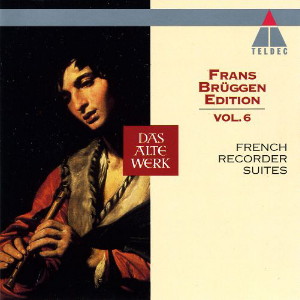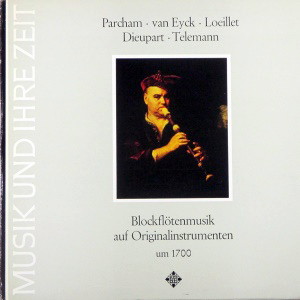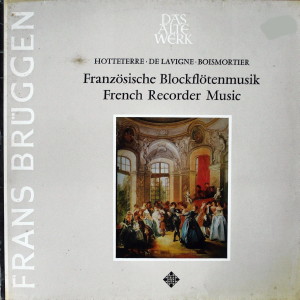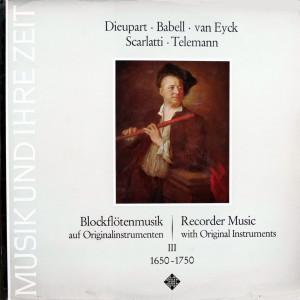 |
|
1 CD -
4509-97468-2 - (c) 1995
|

|
| 1 LP -
SAWT 9482-A - (p) 1966 |
 |
| 1 LP -
SAWT 9570-B - (p) 1970 |
 |
| 1 LP -
SAWT 9582-A - (p) 1972 |
|
| FRANS
BRÜGGEN EDITION - Volume 6 |
|
|
|
|
|
| FRENCH RECORDER SUITES |
|
|
|
|
|
| Charles [?François]
Dieupart (after 1667-1740) |
|
|
| Suite
in G major - fourth flute and
basso continuo |
13' 39" |
|
| 1.
Ouverture |
2'
59" |
|
| 2.
Allemande |
3' 15" |
|
| 3.
Courante |
1' 20" |
|
| 4.
Sarabande |
2' 10" |
|
| 5.
Gavotte |
1' 12" |
|
6.
Menuet en
Rondeau
|
1' 39" |
|
| 7.
Gigue |
1' 04" |
|
|
|
|
| Jacques-Martin
Hotteterre le Romain
(1674-1763) |
|
|
| Premiere
Suitte de Pièces à deux dessus
sans Basse Continue op. 4,
Paris 1712 - two treble recorders |
16' 01" |
|
| 8. Gravement |
2' 11" |
|
| 9. Gay |
1' 41" |
|
| 10. Allemande |
2' 15" |
|
11. Rondeau,
Tendre (Gracieusement)
|
1' 49" |
|
12. Rondeau, Gay
|
1' 25" |
|
| 13. Gigue |
1' 34" |
|
| 14. Passacaille |
5' 06" |
|
|
|
|
Charles [?François]
Dieupart
|
|
|
| Suite
in A major - voice flute and
basso continuo |
17' 55" |
|
| 15. Ouverture |
5' 20" |
|
| 16. Allemande |
4' 24" |
|
| 17. Courante |
1'
37" |
|
| 18. Sarabande |
2'
22" |
|
| 19. Gavotte |
1'
04" |
|
| 20. Menuett |
1'
46" |
|
| 21. Gigue |
1'
22" |
|
|
|
|
| Frans Brüggen, recorder |
The instruments
|
|
| Nikolaus Harnoncourt,
viola da gamba (1-7) |
recorders: |
|
| Gustav Leonhardt,
harpsichord (1-7, 15-21) |
- P.I. Bressan,
England early 18th century fourth
flûte in b flat' - [1-7] |
|
| Kees Boeke, recorder
(8-14) |
- Friedrich von
Huene (after Denner), Boston treble
[alto] in f" - [8-14] |
|
| Anner Bylsma, violoncello
(15-21) |
- Hans Coolsma
(after Bressan), Utrecht treble
in f" - [8-14] |
|
|
- P.I. Bressan,
London c. 1720. Frans
Brüggen Collection voice flute
in d' - [15-21] |
|
|
viola da gamba
[viol]: |
|
|
- Jacob Precheisn,
Vienna 1670 bass - [1-7] |
|
|
harpsichord: |
|
|
- Martin Skowroneck
- [1-7] |
|
|
|
|
|
Luogo
e data di registrazione |
|
- Palais
Schwarzenberg, Vienna
(Austria) - novembre 1965
[1-7]
- Bennebroek
(Olanda) - febbraio 1970 [8-14]
- Doopsgezinde Kerk, Amsterdam
(Olanda) - gennaio & novembre
1971 [16-21]
|
|
|
Registrazione:
live / studio |
|
studio |
|
|
Producer /
Engineer |
|
Wolf
Erichson [8-14] |
|
|
Prima Edizione
LP |
|
- Telefunken
"Das Alte Werk" - SAWT 9482-A -
(1 LP) - durata 48' 01" - (p)
1966 - Analogico [1-7]
- Telefunken "Das Alte Werk" -
SAWT 9570-B - (1 LP) - durata
45' 46" - (p) 1970 - Analogico
[8-14]
-
Telefunken "Das Alte
Werk" - SAWT 9582-A - (1
LP) - durata 52' 43" -
(p) 1972 - Analogico
[15-21]
|
|
|
Edizione CD |
|
Teldec
- 4509-97468-2 - (1 CD) - durata
47' 52" - (c) 1995 - ADD |
|
|
Note |
|
- |
|
|
|
|
The French
composer Charles Dieupart
travelled to London around
1700 and soon found himself
in demand as
a harpsichord teacher. In
1701 he published six
harpsichord suites that left
such a profound impression
on Johann
Sebastian Bach that he
copied two of them out in
order to study them in more
detail. The Prelude of
Bach’s First English Suite
may be based on the theme of
the Gigue from Dieupart’s
Suite in A major.
Dieupart simultaneously
published an edition of
these suites in a version
for recorder (or flute),
violin and continuo,
including precise
instructions as to the
particular type of recorder
on which the suites should
be played: for the first
four a “voice Flute” (tenor
recorder in d') was
demanded, for the last two a
“fourth Flute” (descant
recorder in b
flat').
Jacques-Martin
Hotteterre
was known as “Le Romain”, a
sobriquet that may be
attributable to a visit to
Rome. He
is generally regarded as one
of the foremost members of
the Hotteterre family, whose
scions were famous not only
as composers but also as
instrument makers, in which
capacity they were
responsible for a whole
series of important improvements
to flutes, oboes and
recorders.
Hotteterre's Premiere
Suitte for two high
melody instruments
(“dessus”) is in B minor and
is particularly suited to
the flute, an instrument of
which Hotteterre was
especially fond. In order to
perform it on two treble
recorders, he recommended
transposing it up a minor
third.
Hotteterre's Suitte
was written in the heyday of
French mannerism, a
stylistic trend
characterised by its extreme
ornamentation. The symbols
for these ornaments or agréments
were explained in detail in
tables that the composers of
the time prefaced to their
works. The listener's
attention is drawn in
particular to the use of flattement
(literally “flattering”), a
type of vibrato for wind
players produced by rocking
two fingers
and described by Hotteterre
in his treatise Principes
de la flûte
traversière (Paris
1707).
Both Dieupart and Hotteterre
cast their respective works
in the form of a suite or
series of dances. The
Hamburg writer on music, Johann
Mattheson, described such
dances in 1759 in his
typically graphic and
humorous way; the allemande,
he asserted, was “a serious
and elaborately worked-out
piece whose broken harmonies
bear the imprint of a
contented or satisfied mind
that delights in order and
calm”;
the couraute, by contrast,
expressed “sweet hope”, the
Sarabande "Immoderate
ambition" and the gavotte
"triumphant joy".
Martin Nitz
·····
A brief
history of the
recorder
6.
The recorder in the 18th
century
National
styles: Germany
(I)
The most important
centres of
wind-instrument making
in the 17th and 18th
centuries were the areas
around Frankfurt,
Munich, Leipzig and
Nuremberg, with the last
of these towns of
particular importance.
There is a considerable
body of evidence to
suggest that there was a
lively trade between
Nuremberg and other
towns both at home and
abroad, in spite of the
fact that, in terms of
the manufacture of wind
instruments, Nuremberg
had to contend with
stiff competition from
Venice. Although the
evidence from the 18th
century is less
extensive, there is no
reason to suppose that
trade in woodwind
instruments was any less
buoyant.
In
this field, the Denner
family appears to have
been especially active,
since it is they more
than any other family
who are mentioned in
contemporary documents.
Hieronimus Kynseker was
still alive when Johann
Christoph Denner
(1655-1707)
revolutionised German
woodwind manufacture,
taking over and
perfecting the
constructional
principles developed by
the Hotteterres,
narrowing the bore of
his instruments in order
to brighten their tonal
qualities and sharpening
their scaling in order
to increase the
effectiveness and
carrying-power of their
upper register. Denner
set new standards in
terms of the purity of
tone and intonation of
the instruments that he
made.
Denner was born in
Leipzig in 1655 and was
introduced to instrument
making by his godfather,
the organ builder
Christoph Donat. He
moved to Nuremberg in
around 1666 and entered
his father‘s workshop,
where he learned to turn
game whistles and
hunting horns. In 1694
he provided the town
council with two
“frantzesische Fletten”
(French flutes) or
“Opera-Flöten"
- instruments built
according to French
designs of a kind
previously unknown in
Nuremberg. Indeed,
Denner himself made no
secret of his intense
interest in French
instrument making,
although it remains a
mystery where he
developed his links with
Paris. In
February 1697 he was
granted recognition as a
master craftsman. There
seems little doubt that
he was Nuremberg‘s most
important manufacturer
of woodwind instruments
and that even in his own
lifetime he was
something of a
celebrity. As late as
1784 Christian Daniel
Friedrich Schubart was
able to write that
“Denner’s flutes are
famous all over the
world. They have reached
Constantinople and Isfahan
and even, through
missionaries, China.”
An exceptionally varied
number of instruments by
Denner have survived.
They include 48
recorders, of which no
fewer than 33 are bass
recorders. Of his four
tenor recorders, two are
in d’ and are
either German “voice
flutes” (a tenor
recorder in d’
that was developed in
England) or, more
probably a
higher-pitched tenor
recorder in c’,
using the abnormally
high Chorton
that was found at this
time in Germany and
elsewhere.
In the case of the
treble recorders, there
exists a curious example
of collaboration between
Denner and Hotteterre,
inasmuch as a treble
recorder preserved in
Munich has a head by
Denner, whereas its
other two sections are
by Louis Hotteterre. The
ivory sopranino recorder
in the Historisches
Museum in Basle (cf Vol.
7) is signed only “D”
but it, too, is almost
certainly by Denner.
Other woodwind makers of
the Denner family were
Johann Christophs
brother, Johann Carl
(1660-1702) and his son
Jakob
(1681-1735). Jakob’s
surviving instruments
comprise 12 treble and 6
tenor recorders. All are
very similar in
construction to those
produced by his father.
Particularly well
preserved is a boxwood
treble recorder in the
Musikhistorisk Museum in
Copenhagen (cf Vol.
12) and a carved ivory
treble recorder in the
Royal College of Music
in London.
Peter
Holtslag
Translation:
Stewart Spencer
|
|